- Quick Read
- Deep Read ( 6 Min. )

Why is Christian Science in our name?
Our name is about honesty. The Monitor is owned by The Christian Science Church, and we’ve always been transparent about that.
The Church publishes the Monitor because it sees good journalism as vital to progress in the world. Since 1908, we’ve aimed “to injure no man, but to bless all mankind,” as our founder, Mary Baker Eddy, put it.
Here, you’ll find award-winning journalism not driven by commercial influences – a news organization that takes seriously its mission to uplift the world by seeking solutions and finding reasons for credible hope.
Explore values journalism About usIn Today’s Issue
- Balloons and national security: Benign, an ignored threat, or both?
- Families are leaving public schools. How that may change education.
- Turkey quake: How children experience – and recover from – disaster
- ‘ChatGPT, tell me a story’: AI gets literary
- Acid attack survivors take the lead at this Indian cafe
Monitor Daily Podcast
- Follow us:
- Apple Podcasts
- Spotify
- RSS Feed
- Download
TODAY’S INTRO
In Peru, rising accusations of ‘terrorism’ against protesters
 Howard LaFranchi
Howard LaFranchi
In a Peru in deep political crisis since December, there seems to be no end to the steady parade of social media postings from one faction or another, hurling attacks and no-compromise standpoints at opponents.
As Lima office worker Maribel Fuentes told me as she strolled along the city’s sun-splashed oceanfront Sunday, “It’s too much. I don’t pay attention anymore.”
Yet one video that surfaced last week has caught widespread attention. It shows a phalanx of soldiers marching down a rock-encumbered highway in Peru’s south – a focal point of recent violent and deadly disturbances – singing an anti-terrorist anthem with gusto.
As the soldiers pass, protesters on barren highway shoulders reply, “We are not terrorists! We are campesinos!”
The exchange underscores how what started as a political crisis has increasingly taken on the added dimension of a battle over Peru’s ever-lurking boogeyman of terrorism. Rising accusations of “terrorism” against protesters conjure a traumatic collective memory of the dark years of the 1980s, when a guerrilla war between the Maoist Shining Path and the state cost more than 70,000 Peruvian lives.
The current crisis was touched off in early December when then-President Pedro Castillo attempted to dissolve Congress. Instead Congress had him arrested, and he remains detained.
Mr. Castillo’s vice president, Dina Boluarte, assumed the presidency, and at first her discourse favored dialogue, healing, and reform. But as sometimes-violent protests swept the country and the public’s clamoring for new elections has grown, Ms. Boluarte has increasingly played the terrorism and “public order” cards.
“This indiscriminate use of the ‘terrorism’ tag: Credit it to the [far right] that has been very active in semantic subversion for a number of years,” says Gustavo Gorriti, a Peruvian terrorism expert who has been a source since my days as the Monitor’s Latin America correspondent. He calls it a “conceptual distortion in which many human rights activists, social democratic politicians, investigative journalists ... have been attacked ... as either ‘terrorists’ or ‘pro-terrorists.’”
More plain-spoken was Flor, last name withheld, visiting Lima from the country’s Ancash region – and unhappy that police were barring entrance to Plaza San Martín in the historic center.
“I wanted to visit the plaza, but we’re all kept out as possible terrorists,” she told me Tuesday. “What 80% of Peruvians want is new leadership and a fair shake with the rich. But for that we are called terrorists.”
Share this article
Link copied.

Help fund Monitor journalism for $11/ month
Already a subscriber? Login

Monitor journalism changes lives because we open that too-small box that most people think they live in. We believe news can and should expand a sense of identity and possibility beyond narrow conventional expectations.
Our work isn't possible without your support.
Balloons and national security: Benign, an ignored threat, or both?
Here’s what we are learning about just how many foreign objects, and what type, may be routinely coming into our airspace. Is this mostly an annoyance or a real national security problem that we have been ignoring?

-
Christa Case Bryant Staff writer
The U.S. military’s unprecedented destruction of four objects floating through the upper reaches of North America’s atmosphere raises a difficult question: Is this stuff benign, or a genuine national security problem in the making?
From what we know now, the answer to that may be “both.” Current evidence released about the events of recent days has revealed a mixed picture. U.S. officials remain adamant that the first object was a large, sophisticated spy balloon from China. They have been careful to put the others in a different category, referring to them as smaller, less sophisticated devices traveling on lower-level winds.
But the spy balloon by itself remains a troubling portent for the Pentagon and U.S. defense overall, say some lawmakers, officials, and outside experts.
“There’s a vulnerability that’s clearly been revealed,” says Sen. Dan Sullivan of Alaska, a member of the Armed Services Committee.
And there’s concern that adversaries are aware of some blind spots in the U.S. military’s capabilities.
“These intrusions should be a wake-up call to rebuild our air and space defenses,” says retired Air Force Lt. Gen. David Deptula, former deputy chief of staff for intelligence, surveillance, and reconnaissance.
Balloons and national security: Benign, an ignored threat, or both?
The U.S. military’s unprecedented destruction of four objects floating through the upper reaches of North America’s atmosphere raises a difficult question: Is this stuff benign, or a genuine national security problem in the making?
From what we know now, the answer may be “both.” Current evidence released about the events of recent days has revealed a mixed picture. U.S. officials remain adamant that the first object was a large, sophisticated spy balloon from China. They have been careful to put the others in a different category, referring to them as smaller, less sophisticated devices traveling on lower-level winds.
But the spy balloon by itself remains a troubling portent for the Pentagon and U.S. defense overall, say some lawmakers, officials, and outside experts.
The State Department last week said the balloon, which China insists was a wayward weather balloon, is part of a sophisticated effort that has involved overflights of more than 40 countries across five continents. In recent years, China has breached U.S. airspace with balloons on at least five separate occasions, said officials.
U.S. radars have been recalibrated to look for slow-moving balloon-like objects. That is one major reason more are suddenly being detected. But dealing with the threat in the long term may require more radars, the modernization of existing systems, and more aircraft for the North American Aerospace Defense Command, says retired Air Force Lt. Gen. David Deptula, former deputy chief of staff for intelligence, surveillance, and reconnaissance.
“These intrusions should be a wake-up call to rebuild our air and space defenses,” says retired General Deptula, now dean of the Mitchell Institute for Aerospace Studies, in an email.
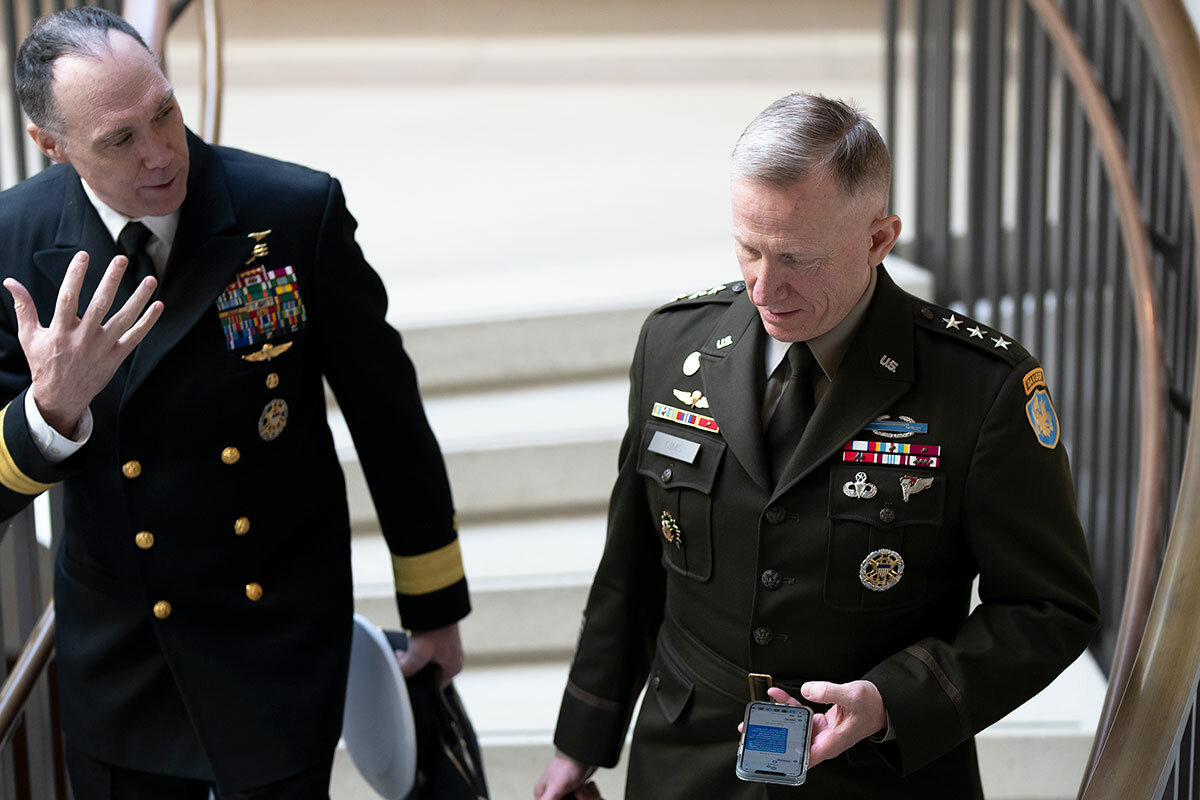
In the short term, some of the U.S. reaction to the radar readings of the last week seems, if not an overreaction, then an abundance of caution in a fast-moving situation where information remains incomplete.
U.S. officials have clearly put the three shoot-downs after that of the alleged Chinese spy balloon in a separate category. They have emphasized not just that the objects were small, but that they appeared incapable of maneuvering under their own power, and were blowing at such low altitudes that they endangered civilian aircraft.
Spy balloons – or properly functioning weather balloons – can rise to 60,000 feet or more, altitudes at which even military aircraft can have trouble operating.
Part of this reticence on the part of the United States is due to tension in its current relationship with China. The White House surely does not want to inflame an already difficult situation unless it has significant proof. Part of it is also due to the fact that thousands of weather and research balloons circle the world at all times. The National Weather Service alone launches some 60,000 such balloons a year, many of them bound for the stratosphere and up to the edge of space.
“There are just a lot more things in the atmosphere we have to worry about,” says retired Vice Adm. Robert Murrett, a former director of naval intelligence who is now an international affairs professor at Syracuse University.
North American Aerospace Defense Command radars have in the past been oriented toward detecting fast-moving aircraft and missiles. Setting them to also detect objects that are moving very slowly would greatly increase the number of radar returns and almost certainly rope in objects of no importance to U.S. national security.
The last three shoot-downs were all so small that it is likely they were virtually vaporized by the Sidewinder missiles that hit them, say experts. Also, unlike the Chinese spy balloon, they were all hit over places where searchers might find it difficult to recover debris – either remote frozen territory, or Lake Huron.
In the absence of proof otherwise, the U.S. intelligence community is indicating the objects may have been harmless, said National Security Council strategic communications coordinator John Kirby on Feb. 14.
“The intelligence community is considering as a leading explanation that these could just be balloons tied to some commercial or benign purpose,” Mr. Kirby told reporters.

Unidentified aerial phenomena
But some experts look at the balloon hunt of the last month in a different context. Given the rising numbers of unexplained aerial sightings by U.S. military pilots over recent years, is it possible that the downing of even one balloon deemed a spy aircraft is an indication that an adversarial surveillance program using balloons, drones, or other low-tech equipment already exists?
Under pressure from Congress, the Defense Department in 2022 established a new organization to investigate unexplained aerial phenomena called the All-Domain Anomaly Resolution Office.
In part, the role of the AARO is to lessen the stigma for pilots of reporting things they cannot explain. In the past many have been derided for believing in aliens and extraterrestrials.
If nothing else, the office has shown that many military pilots see stuff in the wild blue yonder they cannot explain. AARO’s most recent study, released last month, reported 366 newly collected incidents of strange aerial sightings over a 12-month period.
Of those, 26 were characterized as drones. Six were radar clutter. And 163 were characterized as “balloons or balloon-like entities.”
The remaining 171 were characterized, basically, as unknowns – “uncharacterized and unattributed ... reports.”
Some of these “appear to have demonstrated unusual flight characteristics or performance capabilities, and require further analysis,” the report said.
“There’s a vulnerability that’s clearly been revealed,” says Republican Sen. Dan Sullivan of Alaska, a member of the Armed Services Committee.
And why they matter
In Congress, talking about mysterious objects in the sky once drew snickers and jokes about aliens. And there’s still a bit of that. “We didn’t kill E.T.,” quipped Sen. Lindsey Graham of South Carolina after an all-senators classified briefing Tuesday.
But the topic of unidentified aerial phenomena (UAP) has suddenly become a serious matter on the Hill, with lawmakers from both parties pushing the administration for more transparency on what it knows – and what it’s doing about it.
GOP Sen. Marco Rubio of Florida, who has been talking about UAPs for years, is frustrated that some are treating this like a new problem – including the White House, which announced a new interagency team to study UAPs. He was one of the senators who successfully pushed the Defense Department to establish AARO.
“I don’t know why we’re reinventing that wheel,” says Senator Rubio. He and Democratic Sen. Kirsten Gillibrand from New York told the Monitor on their way out of an Intelligence Committee classified briefing Tuesday that they were collecting signatures to get AARO fully funded.
Senator Gillibrand says it’s thanks to that work that the U.S. could trace and track the flight path of a Chinese spy balloon so effectively. “We know a lot more than we knew two years ago,” she says, thanks to mandating UAP incident reporting, which has reduced the long-standing stigma around doing so.
And while senators caution that the unidentified objects may turn out to be benign, there’s concern that adversaries are aware of some blind spots in the U.S. military’s capabilities.
“They know we look for missiles, they know we look for planes, but are we really looking for slow-moving objects at 20,000 feet?” asks Senator Rubio. “And if we’re not, that’s what you would design.”

A deeper look
Families are leaving public schools. How that may change education.
The pandemic led to enrollment declines in public schools across the United States. As more parents mull other options, how are districts rethinking their bottom line – and their mission?

- Quick Read
- Deep Read ( 13 Min. )
Nationwide, U.S. school districts are grappling with slumping enrollments that are putting a dent in budgets and, in some cases, forcing painful decisions about school closures.
The latest data from the National Center for Education Statistics shows that total enrollment in public elementary and secondary schools fell by more than a million students at the onset of the pandemic. The federal government expects an overall decline to continue.
Education officials point to multiple factors, which can vary by region, including declining birthrates, the rise of home schooling, more families choosing private or charter schools, changing migration patterns, and older students who dropped out to join the workforce.
It’s difficult, if not impossible, to determine the degree to which ideological concerns and broader culture wars are influencing enrollment shifts. In Nevada, Washoe County School District Superintendent Susan Enfield says she encourages families to reach out and ask questions. She knows she can’t change every parent’s mind.
“I will never judge the choice a family makes for their child when it comes to their education,” she says. “They know their child. They know what their child needs. My job is to make sure that their public school is a viable option.”
Families are leaving public schools. How that may change education.
On an icy January morning, Superintendent Susan Enfield arrives at Marvin Moss Elementary School with three rubber ducks tucked discreetly in her purse.
She greets staff in the front office before making a beeline toward the wing containing some of the school’s youngest learners. There, she pops into a kindergarten classroom unannounced.
“What’s something you love about your teacher?” she asks the students.
Little hands shoot up. One by one, they share their thoughts, some pausing to find the right words.
“She is fun.”
“She plays with us outside.”
“She helps us learn new things.”
Their bite-size answers set the stage for the unveiling of the Ducky Award, Dr. Enfield’s signature way of recognizing Washoe County School District employees who deserve praise. In this case, a fellow colleague had nominated the school’s three kindergarten teachers for their hard work and dedication. Jodee McLean – the first teacher honored – blushes and smiles while accepting the small yellow duck.
Her students aren’t the only ones who learn about the recognition. Later that day, Dr. Enfield shares photos of the kindergarten teachers on social media. They exist among other posts celebrating student accomplishments and showcasing programs.
As far as the superintendent is concerned, public schools are not always public enough about praising their own people or progress. So she’s on a mission to change that while also not glossing over room for improvement.
In an era of declining enrollment in K-12 public schools, Dr. Enfield considers it crucial to show “why the local public school is a school of choice.”
It’s more than just a sentimental statement. Enrollment dips cost the district money, which eventually can mean fewer services, programs, and resources for students.

Picture a funnel. Federal, state, and local money gather at the top before flowing to districts and, ultimately, schools on a per-pupil basis. Other funding streams exist, often earmarked for specific purposes, but district finances rely heavily on those per-pupil dollars.
Even slight deviations can cause financial problems. Case in point: The Washoe County School District budgeted for 61,923 students this academic year, but 1,145 students didn’t show up. The decline created a revenue shortfall of almost $8.4 million.
The district’s situation isn’t unique. Nationwide, U.S. school districts large and small are grappling with slumping enrollments that are putting a dent in budgets and, in some cases, forcing painful decisions about school closures.
The latest data from the National Center for Education Statistics shows that total enrollment in public elementary and secondary schools fell by more than a million students at the onset of the pandemic – from 50.8 million in fall 2019 to 49.4 million in fall 2020. The federal government expects an overall decline to continue, leading to 47.3 million prekindergarten through 12th grade students attending public schools in 2030.
There is no single explanation for the drop in public school students, some of whom have been called “missing kids” because they seemingly disappeared during the pandemic. Instead, education officials point to multiple factors, which can vary by region, including declining birthrates, the rise of home schooling, more families choosing private or charter schools, changing migration patterns, and older students who dropped out to join the workforce.
Parents opting to skip or delay their child’s kindergarten year may also be playing a role.
“Changes in enrollment inevitably mean school districts are going to have to make hard choices,” says Ray Hart, executive director of the Council of the Great City Schools.

And that’s why Dr. Enfield – seven months into her tenure leading the Washoe County School District – is unabashedly boosting the good occurring in public classrooms while also calling for greater state investments.
Better funding, she says, would enable the district to pay teachers more and provide smaller class sizes, thereby making the system a more enticing option for families.
“A robustly funded public school system is going to be stronger and more appealing to families and serve kids better,” she says. “That’s just the reality.”
Chasing enrollment in Washoe County
Most of Washoe County lies on the eastern slope of the snow-capped Sierra Nevada. The Truckee River cuts through downtown Reno — the county seat nicknamed “the biggest little city in the world” – not far from casinos, parks, coffee shops, and eateries. The other large municipality in the county is Sparks, which sits east of Reno and has more housing, shopping, industrial areas, and a marina.
While small compared to its southern sister Las Vegas, whose metropolitan area makes up the lion’s share of Nevada’s population, much of Reno’s story over the past decade has revolved around growth. A massive industrial complex with tenants such as Tesla, Google, and Walmart brought scores of jobs and, in turn, people to northwest Nevada.
Migration from California and elsewhere also brought new residents. Housing prices soared as demand blossomed. And a Brookings Metro analysis labeled Reno as one of the few American cities that grew more rapidly in 2020-21 compared with the prior year.
But the same can’t be said for the Washoe County School District serving the region. The public school system’s enrollment has decreased 4.3% since the 2018-19 school year.
“I don’t know that we can say it’s just a mass exodus from public education entirely,” says Dr. Enfield, who came to the district in July after serving as superintendent of Highline Public Schools in the Seattle area. “I think it’s an exodus based on need and a completely unanticipated reality that we were all forced to confront during COVID.”

A recent staff presentation to the school board pegged lower birthrates, inflated housing costs, and movement toward charter and private schools as the primary drivers. The district projects another loss of 1,099 students next school year tied to that combination of factors.
In Nevada, public charter schools can be sponsored by traditional public school districts or the Nevada State Public Charter School Authority. Since the 2019-20 academic year, enrollment at charter-authority-sponsored schools has grown by 10,250 students. Six of those brick-and-mortar charter schools operate within Washoe County. The Washoe County School District also sponsors several other charter schools.
“I want our schools to be excellent, and I want every district school to be excellent,” says Rebecca Feiden, executive director of the Nevada State Public Charter School Authority. “And I want families to have the difficult job of picking between a lot of excellent schools.”
As a whole, Nevada’s public school enrollment has seen a nearly 2% decline since the 2019-20 school year, according to an analysis by The Associated Press, Stanford University’s Big Local News project, and Stanford education professor Thomas Dee. Private school enrollment increased by 8% during that same time span. Home schooling likely contributed to the public school enrollment decline as well, though Nevada’s education department does not track that data.
Seventh grader Kylie Skolnick is one of the students the Washoe County School District lost. Her parents, unhappy with a variety of issues at the public middle school where Kylie attended sixth grade, began home-schooling her this year.
Maria Skolnick, her mother, says concerns about curriculum direction, school safety, and what she and her husband viewed as an erosion of parental rights drove their decision. Core academic subjects, she says, seemed on the back burner as social justice and LGBTQ issues gained more prominence in the school setting.
“It was just this separation of allowing the school district to take charge of what they felt was necessary or deemed important for the kids to be learning,” says Mrs. Skolnick, who felt like it was “kind of pushing parents out.”

Their younger daughter, a fourth grader, remains in a public elementary school because they have not observed the same issues there. Meanwhile, Kylie studies at home and once a week attends in-person classes with a home-school gathering called Light House Reno.
The group meets at a church, where, on a recent afternoon, teacher Kari Clauson leads a discussion about how to write short, impactful sentences. Fourth through eighth graders surround a table in the small classroom that contains a large, wooden cross in one corner.
Interest in Light House Reno, which serves roughly 35 children and charges fees based on the number of classes they attend, has surged since it launched at the beginning of this school year, says Rachel Radmacher, the group’s founder and administrator. She expects the number of children attending to double next year.

“We’re trying to figure out how to do it. We might split it into two days,” Mrs. Radmacher says. “And I’m hopeful that we’ll be able to offer more classes. I’d like to start a theater program and I would like to have a Spanish class.”
Two of Mrs. Radmacher’s three children are home-schooled and part of Light House Reno; her middle son, who has been diagnosed with autism, attends the public school district to receive support services. Ideological concerns about public school curriculum also drove her decision to home-school.
Seeking help from legislators
It’s difficult, if not impossible, to determine the degree to which ideological concerns and broader culture wars are influencing enrollment shifts.
As a public school leader, Dr. Enfield says she encourages families to reach out and ask questions. She suspects some perceptions about public schools have evolved from hearsay.
Dr. Enfield says she can’t dwell on it, nor can she change every parent’s mind.
“I will never judge the choice a family makes for their child when it comes to their education,” she says. “They know their child. They know what their child needs. My job is to make sure that their public school is a viable option.”
But there is another group of impressionable people she hopes to sway: state lawmakers.
Nevada’s citizen legislature, which meets every other year, convened in early February for its 120-day lawmaking session. A day after her visit to Marvin Moss Elementary School, which saw enrollment decline by 50 students at the beginning of the pandemic, Dr. Enfield spoke with legislators in Carson City.
In her mind, adequate funding and enrollment have a “definite correlation” given the domino effect it would have on teacher recruitment, class sizes, and overall resources. That’s the message she has been sharing with state lawmakers.
“A lot of the things that families would like to see, we could provide if we had adequate funding,” she says.
What’s a Teacher Worth?
Public-school teachers run on passion for their work and for the kids in their classrooms. That work is vital to a thriving society. But teachers also are widely regarded as being underpaid – often moonlighting to get by. A Monitor education writer looks at a push to create a higher baseline for compensation in a story that really extends to equality and fairness. Hosted by Clay Collins.
Nevada’s public school enrollment decline is more modest than what other states are experiencing, including neighboring California. But its historically low per-pupil funding means districts were already operating on thin margins. A recent Education Law Center report gave Nevada F grades in three funding fairness measurements.
The problem with enrollment declines is that many fixed costs of running a school system – building and maintenance needs, for instance – remain the same, says David Sciarra, executive director of the Education Law Center.
“What I would call lack of investment in Nevada’s public education system by successive legislators and governors for decades ... is going to come home to roost,” he says. “And these districts are really going to have a tough time.”

The Washoe County School District overcame its budget shortfall this academic year by moving 60 teachers who had been on special assignment – doing various types of work, such as professional development or supporting staff – back to the classroom, saving more than $2 million, Dr. Enfield says. Contingency funds covered the remaining gap.
Other districts have turned to federal COVID-19 relief money to plug enrollment-related budget holes, says Marguerite Roza, director of the Edunomics Lab at Georgetown University. The availability of those one-time federal funds – most of which must be spent by September 2024 – has created a situation, she says, where districts have not “reckoned with” the financial implications of enrollment declines.
The exodus of more than a million students from public schools nationwide, however, has led to school closures in places such as Oakland, California, and Jefferson County in Colorado. Bellevue School District in Washington is reviewing plans to do the same.
And while many education officials shy away from discussing that scenario, Dr. Roza says that can be a mistake.
“I think there is this wishful thinking happening that there’s got to be a better way than closing schools,” she says. “And the only other alternative is kids go to these zombie schools where there are very few services and very few adults who work there.”
If any city knows the effects of dwindling enrollment all too well, it’s Chicago. Mass migration out of the Windy City, among other factors, led to a 25% enrollment decrease within Chicago Public Schools over the past decade.
In 2013, the school board voted to close 49 schools. Now, a moratorium on school closings in Chicago exists until 2025.
While students may see smaller class sizes when enrollment shrinks, they often don’t have access to many electives or extracurricular activities, says Hal Woods, chief of policy at Kids First Chicago. The nonprofit organization has been studying the enrollment crisis and boosting parent engagement around the issue.
“It just sets up a very, very challenging environment for students to succeed – both the student outcomes but even being able to offer, like, a quality experience for students and faculty in the school building,” he says.
Consuelo Martinez, who lives in the South Side of Chicago, is part of a team affiliated with Kids First Chicago that has convened parents to discuss enrollment dips and study their root causes. Over more than a decade of having children in public schools, she says, through a translator, she has seen firsthand the effects of shrinking enrollment. At her son’s school, for example, first and second graders were taught in one room.
Her son, now 21, is in college. Her 19-year-old daughter, who has been diagnosed with autism, remains a Chicago Public Schools student and is receiving extended support services.
The group Ms. Martinez is working with plans to make recommendations for policy changes. It’s an acknowledgment that Chicago Public Schools cannot solve the problem on its own.
“This is going to actually require government, private sector, [and the] civic community coming together to really address some of these root causes – systemic issues – that are causing slower growth, but also causing families to leave the city of Chicago as well,” Mr. Woods says.
“We could be surprised”
Back in Nevada, public education leaders say school closures are not imminent in the state’s two largest districts.
The Clark County School District in the Las Vegas area saw its enrollment fall by nearly 2%, or roughly 5,800 students, this academic year. That puts its student count in the ballpark of 314,000, still keeping its position as the nation’s fifth-largest public school district.
Jason Goudie, the chief financial officer for the Las Vegas district, says he considers the decrease “somewhat flat.” In other words, it has not caused a fiscal panic.
“We are still an overcrowded district,” he says. “We still don’t have enough schools, enough capacity.”

The Washoe County School District, meanwhile, is in the midst of a five- to 10-year facilities modernization plan. It will look at anticipated growth spots, where a new school may be warranted, while also evaluating whether any consolidation should occur, Dr. Enfield says.
The bottom line, the superintendent says, is about making smart decisions for how to allocate resources. She says this all with an air of optimism, though.
Nevada Gov. Joe Lombardo, a Republican who took office in January, has announced his proposed biennial budget, which would pump $2 billion more into public schools. He estimates it would increase per-pupil funding by more than $2,000.
Anything could happen, of course, as his budget wends its way through the state legislature, where competing funding requests go head to head. Dr. Enfield plans to make her presence felt in the state capital as an education messenger of sorts.
She’s also not ruling out the possibility of the enrollment situation reversing itself.
“I know that we’re predicted to be down,” she says. “And I still think we could be surprised in the other direction.”

Turkey quake: How children experience – and recover from – disaster
Trauma affects children differently than adults. But as Turkey and Syria attempt to recover after their deadly quake, research shows that children also exhibit high degrees of resilience, especially when the community steps in.

- Quick Read
- Deep Read ( 5 Min. )
-
By Erin O'Brien Contributor
The massive earthquake that struck Syria and Turkey last week has killed more than 41,000 people and displaced over a million more, according to Turkish government statistics. Among those affected are 7 million children living in the regions that were hit, according to UNICEF.
Thousands of children have died, and thousands more have lost a parent or caregiver or both, although no concrete estimates of that number yet exist. Rescue workers are rushing to attend to their needs in the crucial days ahead.
Among the most critical priorities is identifying unaccompanied children. Following this scale of disaster, UNICEF says, children separated from family are vulnerable to violence, exploitation, and abuse. Children rescued from under the rubble who have lost their families – many of them so shocked into silence they do not know their own names – have been left in the care of pediatricians.
Those with their families are dealing with the traumas of homelessness and hunger – and watching their caregivers suffer. Children face unique vulnerability after a natural disaster. But research also shows that children are uniquely poised to withstand tragedy, especially when support networks step in to provide care.
Turkey quake: How children experience – and recover from – disaster
Children covered in dirt and grime, many shoeless, wait for food in a field outside a camp for internally displaced people in this southeastern Turkish city. Many of the children are Kurdish, many impoverished, and now, in the wake of the 7.8 magnitude earthquake that hit this region last week, many are homeless.
They sleep in tents, curled up next to cousins and siblings, trying to stay warm.
Here in Gaziantep, they wait for aid. When the government supply truck arrives, usually once a day, they run toward its white, hulking form. The truck stops, and a young man, dressed in civilian clothes, leans out of the back.
The children scramble toward the open hatch, trying to climb inside. The man uses a stick to push them back. He throws a blanket or two into the teeming crowd, but no food.
As the truck lurches forward, children are still hanging from its back. Their shoeless feet drag on the ground as the truck speeds up, some running to try and keep up. Others try to clamber inside the moving vehicle.
As quickly as it arrives, the truck is gone, leaving a trail of fallen children in its wake.
“The children are hungry. They are scared,” says Kiraz Balik, who is alone in Gaziantep with her seven children – among some 200 estimated to be at this informal camp alone – because her husband is in prison.

The massive earthquake that struck Syria and Turkey last week has killed more than 41,000 people and displaced over a million more, according to Turkish government statistics. Among those affected are 7 million children living in the regions that were hit, according to UNICEF spokesperson James Elder, speaking to reporters in Geneva.
The images of children being rescued after days under collapsed buildings have captured the world’s attention. But thousands of children have died. Thousands more have lost a parent or caregiver or both, although no concrete estimates of that number yet exist.
Children face unique vulnerability after a natural disaster, and in this region their plight is overlapped with poverty, and across the border in Syria with displacement and civil war. But research also shows that children are uniquely poised to withstand tragedy, especially when support networks step in to provide care.
Finding the parents
For now, rescue workers are rushing to attend to their needs in the crucial days ahead.
“Urgently identifying unaccompanied children and those who may have been separated from parents and caregivers is absolutely critical,” UNICEF communications specialist Joe English told CNN. “Following these kinds of disasters, displaced children, especially those who are unaccompanied or separated from family, are vulnerable to violence, exploitation, and abuse, including the risk of trafficking or gender-based violence.”
Children rescued from under the rubble who have lost their families – many of them so shocked into silence they do not know their own names – have been left in the care of pediatricians.
Those with their families are dealing with the trauma of homelessness and hunger – and watching their caregivers suffer. Many more will soon be born into this tragedy. The United Nations Population Fund estimates that at least 214,000 pregnant women have been affected by the quake, and that 24,000 women could give birth in the next month. In the city of Islahiye, in Gaziantep province, rescue workers reported that women were giving birth in tents next to rescue sites.
Children display trauma in unique ways. According to research published in The New England Journal of Medicine, as part of a survey of stress reactions to the 9/11 attacks, “children are among the most vulnerable for long-term psychological disorders and impairment” in the aftermath of disaster. They often become anxious about leaving their caregivers, are unable to perform in school, and become hypervigilant. At least 35% of families surveyed in studies after 9/11 said their children displayed some symptoms of post-traumatic stress.

The severity of response can also be directly linked to post-event exposure. In other words, if a child is left near rubble or bodies, or watches coverage of an event incessantly following a disaster, they are more likely to display PTSD symptoms.
Increasingly, however, mental health research is focused on their resilience. In a paper on pediatric responses to trauma, Dr. Froma Walsh from the University of Chicago found that “acute stress symptoms” are common in the immediate aftermath of an event. However, most people, including children, are resilient in coping and adaptation and exhibit transformation and positive growth, she finds.
That’s especially true with early interventions in community settings like schools or hospitals.
This will be complicated in Turkey and Syria, where many traditional institutional structures critical to children’s recovery – such as schools and hospitals – are currently inaccessible. Schools are closed until at least March 1, and even when they open, many displaced children will not be registered to attend. Hospitals are teeming and overcrowded with earthquake victims. In some cities, such as Antakya, almost all of them have been destroyed.
Dr. Walsh’s study also points to the importance of the family and community structure “when their strengths and potential are mobilized.” The symptoms of children who experience trauma, she writes, greatly depend on whether children can seek support within their networks.
Tightknit community
In a region such as southeast Turkey, where families are large and tightly knit, this is positive news. In the makeshift camp in Gaziantep, Genco Demir, a Kurdish man overseeing the tents, says that everyone here is related.

“There are many people here watching other people’s children,” says Talibe Gezgin, a young mother at the camp who is four months pregnant.
On a recent day in the middle of the tent city, erected by this community of Kurdish migrant farmers on the first day after the earthquake, a group of nine children has made up a game. One girl, no more than 10 years old, wiggles a found piece of string on the ground, like a snake. Two groups of children – four on each side – squat on either side of the string. When she instructs, they jump over the rope.
They seem aware of some tragedy, some disruption, but they smile and hold each other close. They play all day. They talk about how they miss school – how they can’t wait to go back.
Their parents, circled around them, are worried. None of them can get the government aid they need to feed their children or take care of their own medical needs; the government has promised victims of the earthquake 10,000 lira, some $530, per family, but they do not know where to go to get it.
But amid the trash and tents, the children laugh.

The Explainer
‘ChatGPT, tell me a story’: AI gets literary
Artificial intelligence programs like ChatGPT can now produce convincingly human-sounding essays with minimal effort from users. It’s a massive timesaver – and an ethical quandary.

- Quick Read
- Deep Read ( 3 Min. )
Advances in artificial intelligence have long stirred ethical debates around intellectual and creativity property rights, but the recent arrival of ChatGPT – a search engine chatbot launched in November 2022 – has turbo-boosted those existential questions across classrooms and executive suites alike.
People have been using the AI algorithm to answer questions from the creative to the efficient, such as drafting project reports, writing basic legal contracts, and summarizing historical events. ChatGPT can also help teachers by developing study guides and creating quizzes. The chatbot’s potential could automate more jobs, too, replacing customer service operators with digital assistants.
But many argue there needs to be more human accountability and integrity in place before allowing anyone to log in to ChatGPT and look for answers. Already educators in high school classrooms and on university campuses are raising concerns about plagiarism and academic integrity when they have discovered students using ChatGPT to complete homework assignments.
“The answers [generated by ChatGPT] are clear and often pretty decently written, but you have no way of knowing if they’re true,” says Nir Eisikovits, director of the Applied Ethics Center at UMass Boston. “People getting information from technology that has no conception of meaning and truth is problematic.”
‘ChatGPT, tell me a story’: AI gets literary
Advances in artificial intelligence have long stirred ethical debates around intellectual and creativity property rights, but the recent arrival of ChatGPT – a search engine chatbot launched in November 2022 – has turbo-boosted those existential questions across classrooms and executive suites alike.
Big Tech is spurring the momentum behind a wave of user-friendly AI tools. OpenAI, the parent company behind ChatGPT, previously made DALL-E, an AI that generates digital images from written queries.
In late January, OpenAI secured a multibillion-dollar investment from Microsoft for ChatGPT, its newest groundbreaking algorithm, which is capable of crafting convincing prose in response to various prompts.
How does ChatGPT work?
ChatGPT is currently available for free at OpenAI’s website. About 100 million people used ChatGPT in January, according to one estimate, which would be the fastest-growing user base ever.
Once registered with an email account on the website, a user can start a text conversation with ChatGPT and receive results within seconds. The machine is fast and prolific, generating answers and expanding upon ideas on screen. First prompts for ChatGPT might be simple like: “What’s the square root of 324?,” “Give me the history of the United States,” or “Write me an essay about the Bermuda Triangle.” The bigger questions come later, like “What is ChatGPT?”
“ChatGPT is a language model developed by OpenAI that uses advanced artificial intelligence to generate
human-like text,” ChatGPT responded to such a prompt. “In simple terms, ChatGPT is a program that can understand and generate text, like a human, by learning patterns in language from vast amounts of text data.”
What are the benefits of ChatGPT?
People have been using the search engine algorithm to answer questions from the creative to the efficient, such as drafting project reports, writing basic legal contracts, and summarizing historical events. ChatGPT can also help teachers by developing study guides and creating quizzes. The chatbot’s potential could automate more jobs, too, replacing customer service operators with digital assistants.
It can even write poems about scanning groceries at the self-checkout in the style of Shakespeare.
Oh wondrous machine, with thy buttons and beeps,
Thou art a marvel, of technology’s leap.
At the self-checkout, I do stand in awe,
As I scan each item, and watch as thou dost saw.
Thy sensors doth read, each barcode with care,
And the numbers doth appear, with nimble repair.
I place each item, within thy basket fair,
And watch as thou dost count, with neither flaw nor snare.
That sounds cool and spooky. What are the concerns around using ChatGPT?
Not everyone is convinced that ChatGPT is ready for public use, and many argue there needs to be more human accountability and integrity in place before allowing anyone to log in and look for answers. Already educators in high school classrooms and on university campuses are raising concerns about plagiarism and academic integrity when they have discovered students using ChatGPT to complete homework assignments and provide answers on tests.
ChatGPT’s answers are also only as good as the information the AI learns from, which can include socially unacceptable material such as conspiracy theories, Nazi propaganda, or racist hate speech. While OpenAI has implemented filters in ChatGPT that should prevent it from using such material in its answers, some users have found ways to bypass those constraints and get the AI to produce all-too-human-sounding rants and screeds.
“The answers [generated by ChatGPT] are clear and often pretty decently written, but you have no way of knowing if they’re true,” says Nir Eisikovits, director of the Applied Ethics Center at UMass Boston. “People getting information from technology that has no conception of meaning and truth is problematic.”
But ChatGPT and other artificial intelligence programs like it are being embraced by working professionals. In fact, 27% of professional workers – mostly in advertising and marketing – say they have used ChatGPT and other AI tools to help them with work-related tasks, according to a survey conducted by the social network Fishbowl. The prevalence in the workplace raises another host of concerns.
“[People] need to understand better the kind of data about the AI is trained on. They need to understand the predictive models assumptions that AI runs on,” cautions Professor Eisikovits.
It’s a limit that even ChatGPT has been programmed to be aware of. “Although ChatGPT can provide information and answers,” the AI responded when prompted, “it’s important to understand that its responses are not always accurate, and should not be taken as fact without further verification.”

In Pictures
Acid attack survivors take the lead at this Indian cafe
In India, the scars from acid attacks are often psychological as well as physical. A cafe run by survivors provides a sense of purpose and belonging for these resilient young women.

- Quick Read
- Deep Read ( 3 Min. )
-
By Shefali Rafiq Contributor
-
Saqib Mugloo Contributor
Every year, hundreds of acid attacks are reported in India, the majority of which are aimed at women. The government has so far been unable to stop the violence, despite laws criminalizing the attacks and restricting the sale of acid.
The women targeted are not only physically injured, but also often left depressed or ashamed by the accompanying disfiguration or disability. But at Sheroes, a cafe staffed and managed by acid attack survivors, they’ve formed a tightknit community. Through their work and through relationships forged at the cafe, survivors reclaim a piece of their dignity.
Anshu Rajput, who works at the cafe, was 15 when a man threw acid on her face. She underwent multiple surgeries to save her eyesight. “The harder part, though, was to overcome the numbness, and that is something I would not have been able to do without Sheroes,” she says.
The women’s resilience rubs off on customers as well.
Ajay Sharma says whenever he feels low, he heads to the cafe. “You see these girls running it; they are amazing and special. I have never witnessed such determination and grit in my entire life,” he says. “They heal me.”
Acid attack survivors take the lead at this Indian cafe
On a sunny afternoon, a young woman named Ritu Saini serves tea to customers at Sheroes, a cafe managed and staffed by survivors of acid attacks. These resilient women have found a supportive place where they can move forward with their lives.
Every year, hundreds of acid attacks are reported in India, with the majority of those aimed at women. The government has so far been unable to stop the violence, despite laws specifically criminalizing the attacks and restricting the sale of acid.
Ms. Saini was a lively teenager before a cousin threw acid on her face for turning down his relationship proposal. She had to undergo extensive treatment, and the attack left her with a scar.
Depressed, she confined herself at home. It took months of her mother’s encouragement for Ms. Saini to go out without covering her face. “That attack left a deep scar on my soul. If not for my mom’s persistence, I wouldn’t have been here today,” she says.
Ms. Saini is determined to empower other women. “I got many opportunities, thanks to the cafe,” she says.
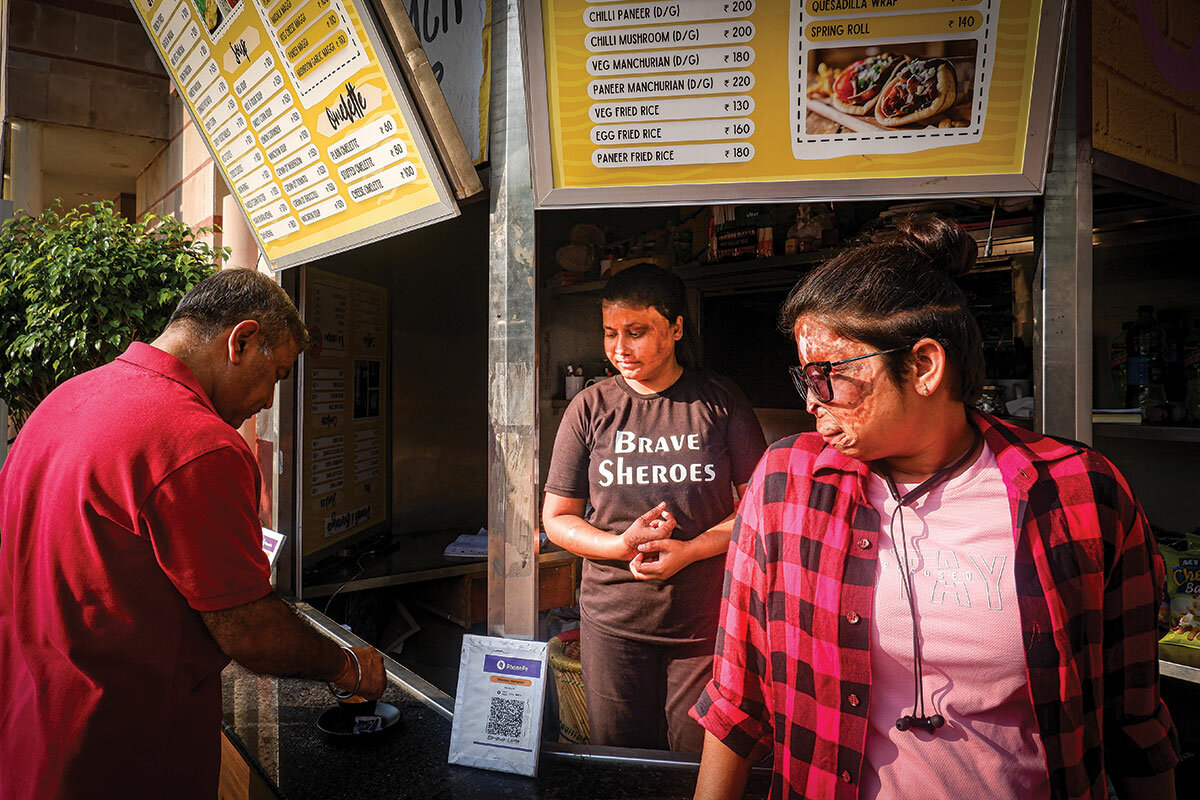
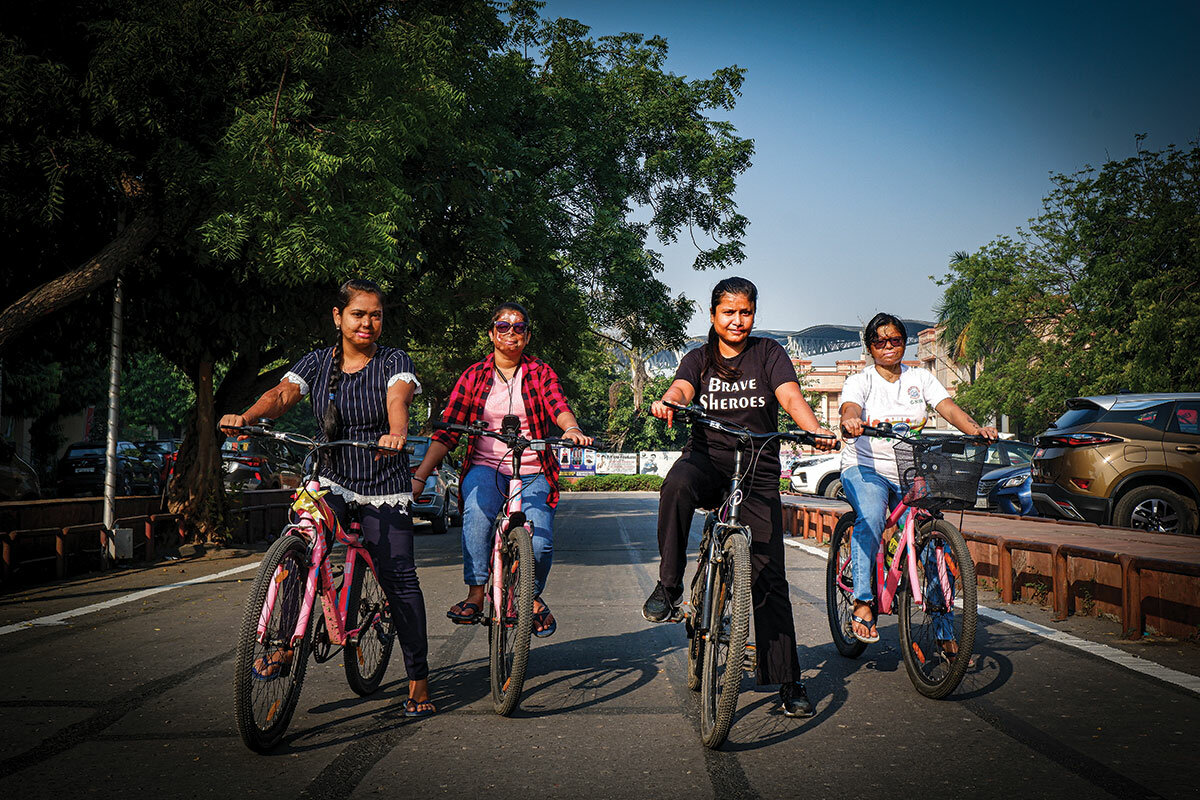
She is joined by five other women, all of whom have stories of pain and resilience to share. Among them is Anshu Rajput. She was 15 when a man threw acid on her face. She underwent multiple surgeries to save her eyesight. “The harder part, though, was to overcome the numbness, and that is something I would not have been able to do without Sheroes,” she says.
The cafe is a project of the Chhanv Foundation, a nonprofit organization in India working for the rehabilitation of acid attack survivors.
Ms. Rajput intends to become a motivational speaker and help people struggling with thoughts of suicide. “I want to tell people to never give up. No matter how hard life gets,” she says with a smile.
Another survivor, Seema Rajput (no relation), recently arrived at the cafe. She finds hope from working with her colleagues. “These girls are like my sisters,” she says.
Customer Ajay Sharma says whenever he feels low, he heads to the cafe. “You see these girls running it; they are amazing and special. I have never witnessed such determination and grit in my entire life. They heal me,” he says. “They are like my daughters.”
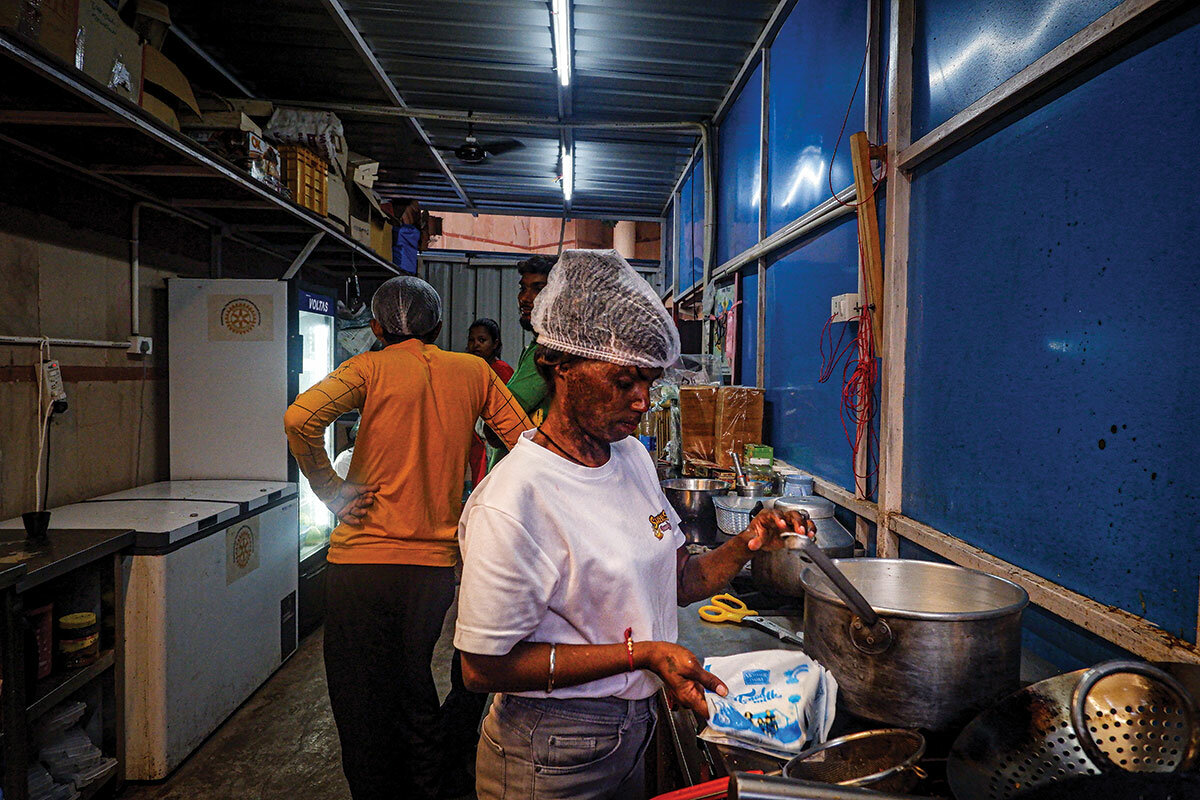
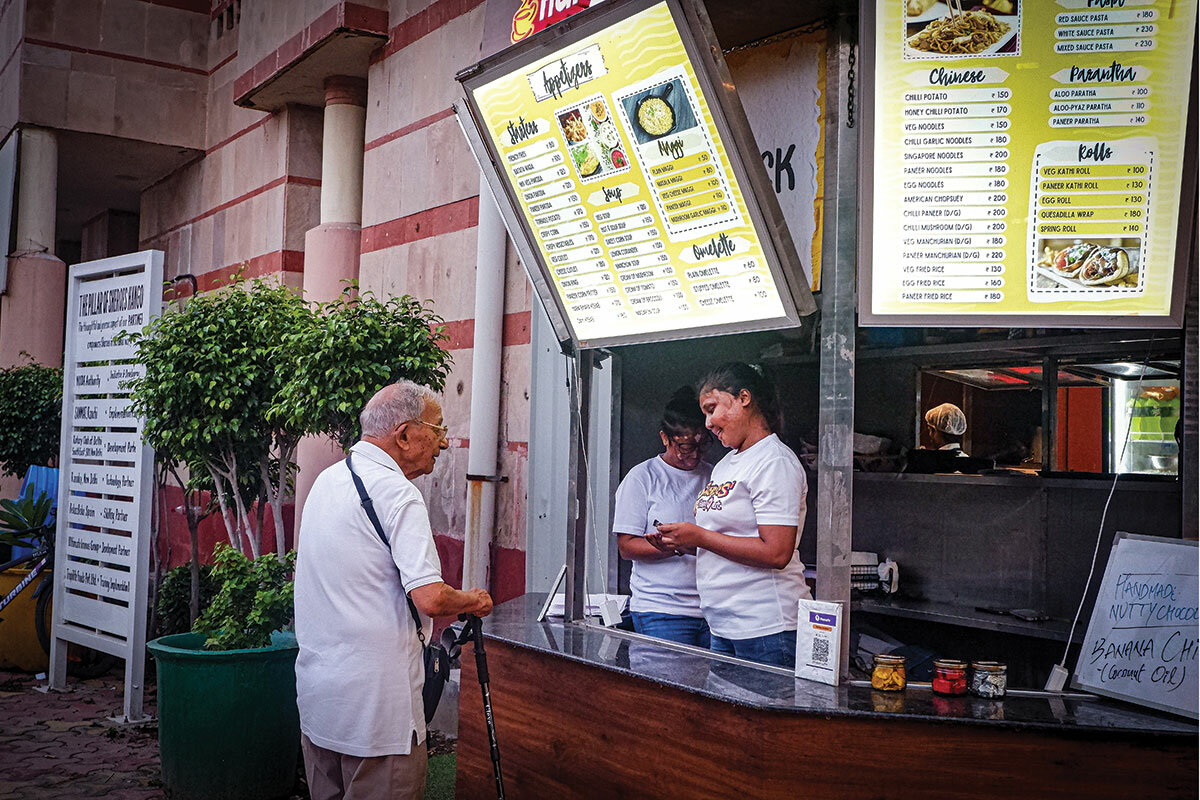
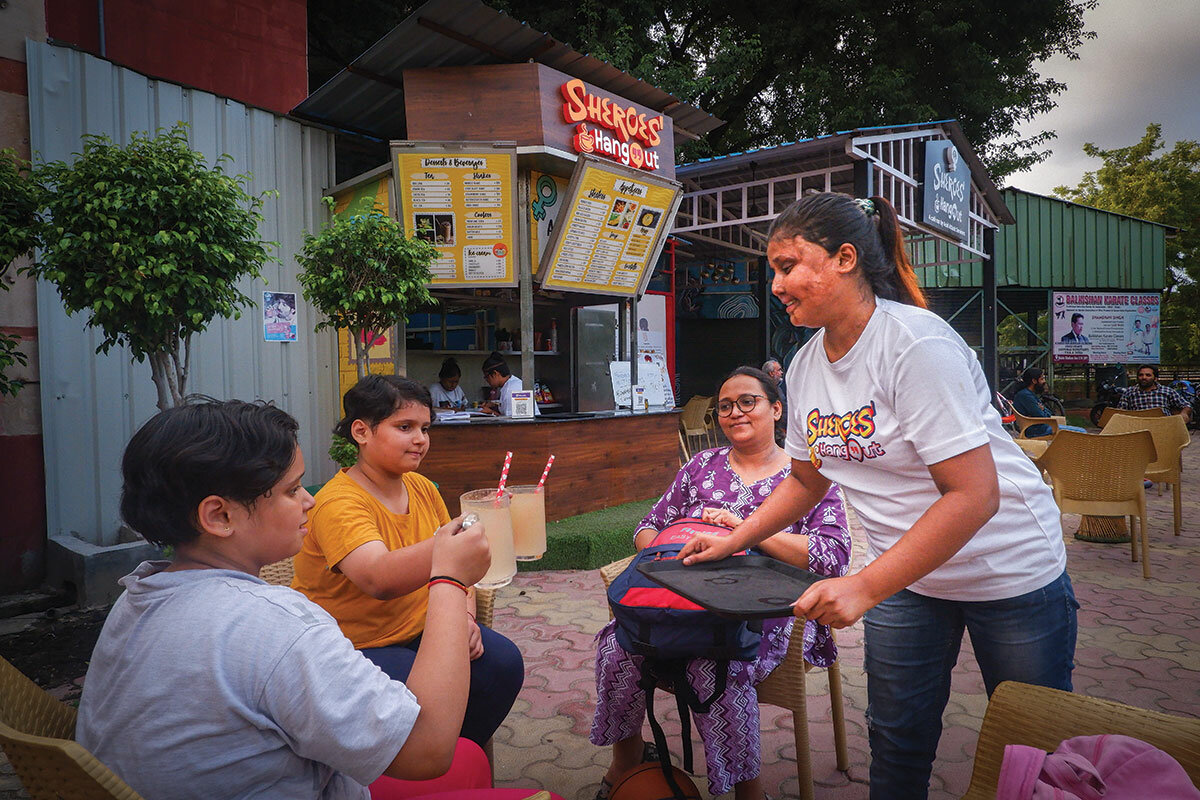

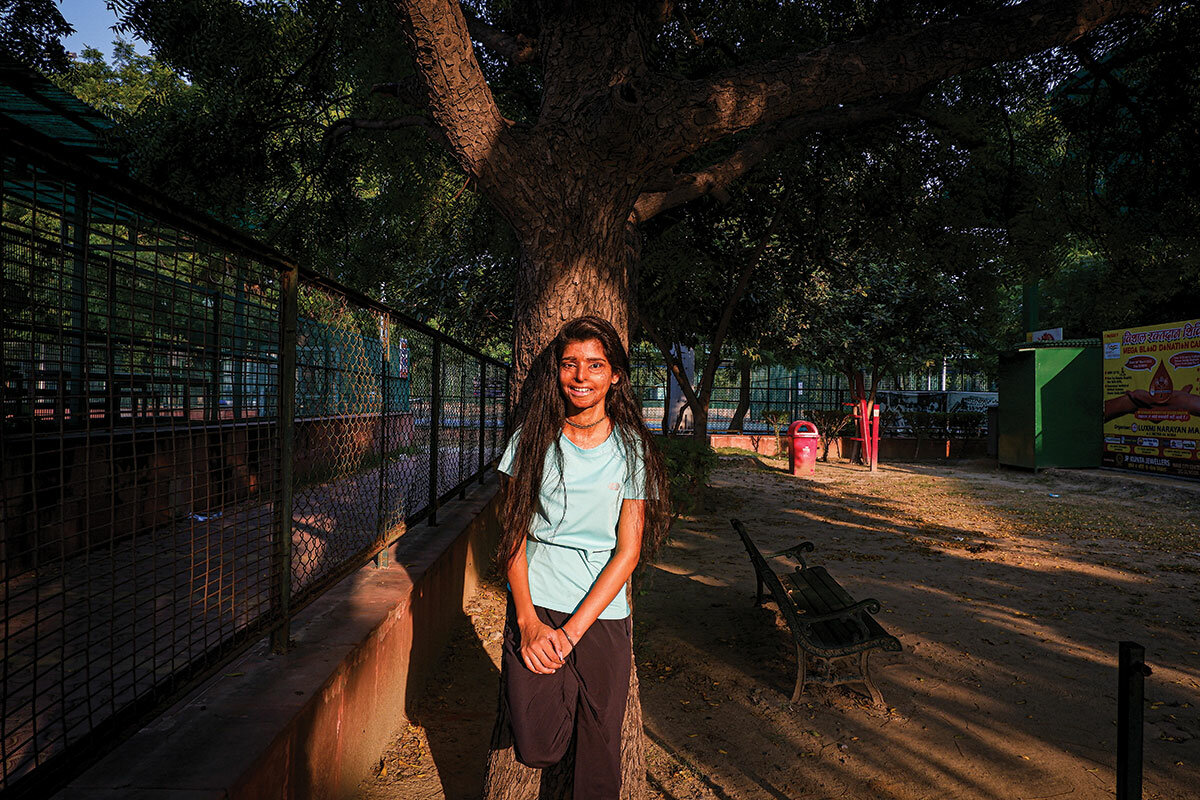
Other headline stories we’re watching
(Get live updates throughout the day.)The Monitor's View
Earthquake aid as a peacemaker
- Quick Read
- Deep Read ( 2 Min. )
-
By the Monitor's Editorial Board
Most wars are won by military advantage. Some are determined by something else. In Syria, after 12 years of a civil conflict, compassion toward the survivors of the Feb. 6 earthquake could provide a turning point that guns have not.
On Monday, President Bashar al-Assad agreed to open two border crossings from Turkey and allow humanitarian aid to flow into northern areas controlled by anti-regime rebels. His concession marks a breakthrough in the relief effort. Nearly 9 million people lack food, water, and shelter following the massive tremor.
The United Nations had to break through persistent resistance from the Assad regime and its principal backer, Russia, to keep just one aid corridor open. Now there are three. While the Assad regime may exploit its concession to gain international recognition, the aid flow could also help change the dynamics of diplomacy in the region.
The opening of aid corridors in Syria may be temporary. But it shows that aggression is an uncertain force. It ultimately backs down to humanity’s demand to aid and uplift.
Earthquake aid as a peacemaker
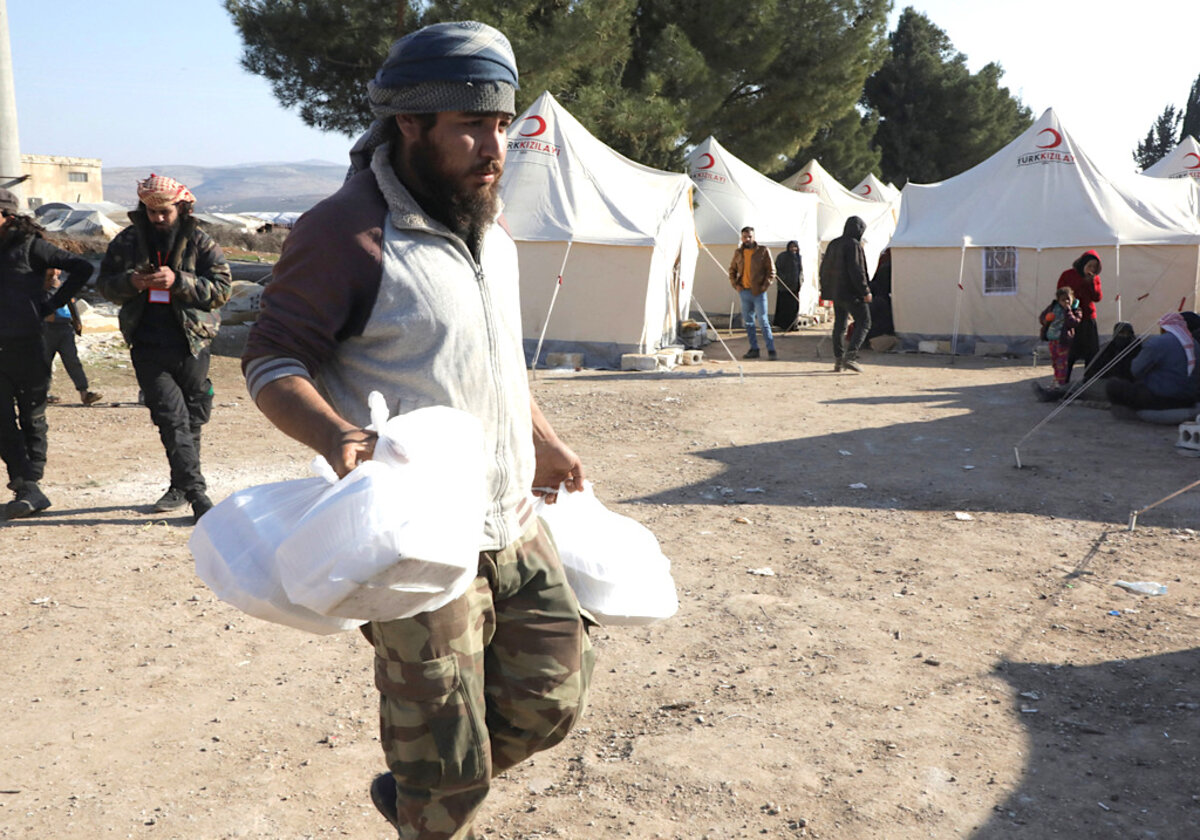
Most wars are won by military advantage. Some are determined by something else. In Syria, after 12 years of a civil conflict, compassion toward the survivors of the Feb. 6 earthquake could provide a turning point that guns have not.
On Monday, President Bashar al-Assad agreed to open two border crossings from Turkey and allow humanitarian aid to flow into northern areas controlled by anti-regime rebels. His concession marks a breakthrough in the relief effort. Nearly 9 million people lack food, water, and shelter following the massive tremor. Truckloads of critical supplies are now reaching areas long isolated and pummeled by war.
The United Nations had to break through persistent resistance from the Assad regime and its principal backer, Russia, to keep just one aid corridor open. Now there are three. While the Assad regime may exploit its concession to gain international recognition, the aid flow could also help change the dynamics of diplomacy in the region.
Since the start of the civil war – triggered by peaceful pro-democracy protests in 2011 – the government has sealed off northern Syria and treated its people there as enemies. Now Mr. Assad’s gesture on aid relief shows that even the most hardened dictators are not immune to the moral imperative to aid and protect innocent life.
A similar approach recently worked in nudging Russian President Vladimir Putin to back, however grudgingly, the resumption of grain and fertilizer shipments from Ukraine to countries facing famine. In Ethiopia’s civil war, the U.N. persuaded the regime to agree to a peace deal in November to provide relief in war-ravaged Tigray province.
Just a few weeks ago, it would have been hard to imagine the Syrian regime making this kind of statement through its ambassador to the U.N. “Syria supports the entry of humanitarian aid into the region through all possible cross points whatever – from inside Syria, or across the borders – for the period of three months to ensure the delivery of humanitarian aid to our people in ... northwestern Syria,” said envoy Bassam Sabbagh on Monday.
When a tragedy like an earthquake strikes, the suffering can soften hearts, temporarily curbing differences and leading to enough trust to make compromise possible.
The opening of aid corridors in Syria may be temporary. But it shows that aggression is an uncertain force. It ultimately backs down to humanity’s demand to aid and uplift.

A Christian Science Perspective
Each weekday, the Monitor includes one clearly labeled religious article offering spiritual insight on contemporary issues, including the news. The publication – in its various forms – is produced for anyone who cares about the progress of the human endeavor around the world and seeks news reported with compassion, intelligence, and an essentially constructive lens. For many, that caring has religious roots. For many, it does not. The Monitor has always embraced both audiences. The Monitor is owned by a church – The First Church of Christ, Scientist, in Boston – whose founder was concerned with both the state of the world and the quality of available news.
How I’m praying after the Michigan State shooting
- Quick Read
- Read or Listen ( 2 Min. )
-
By Rick Lipsey
A father of a Michigan State University student shares ideas that have inspired his prayers for the community in the wake of the recent tragedy there.
How I’m praying after the Michigan State shooting
One of my sons is a freshman at Michigan State University, where a mass shooting took place on Monday night. He called me that night at my home in New York and said, “Dad, there’s a shooting and people have been killed here, but I’m OK.”
I was grateful to hear from him, and my heart went out to this community and everyone affected. So I said to my son, “Let’s pray,” which is something I’ve consistently found helpful in troubling or tragic situations.
We talked about embracing the entire campus and community in our prayers, and that included praying about our view of the alleged gunman. Why include this in one’s prayers when someone has done such a terrible thing, and in a location that put a loved one at risk? Simply put, because such prayer keeps us from succumbing to the temptation to look for and expect the worst in others in the future. It provides protection, comfort, and healing. And I’ve learned through experience and through studying the Bible and the writings of Mary Baker Eddy, the discoverer of Christian Science, that the most effective prayer embraces all.
“Love your enemies,” Jesus says in the Bible, “do good to them which hate you, bless them that curse you, and pray for them which despitefully use you” (Luke 6:27, 28).
This doesn’t mean loving, or even tolerating, wrongdoing. It’s about recognizing that God doesn’t see good people and bad people. God sees us precisely and only as the way He created us: not as mortals defined by mental darkness or dangerous tendencies, but as spiritual ideas filled with pure goodness, reflecting His infinite good.
Getting even a tiny glimpse of that spiritual reality in one’s heart can be life-changing.
Years ago, a group of young men attacked me one evening on a sidewalk in New York City. They jumped on me, and as I lay on the bottom of the pile of men punching and kicking me, I prayed. Though the men weren’t behaving in such a manner at that moment, I knew that at their core they too were God’s children, made to be loving and to be loved. Their genuine identity was spiritual, God-filled, pure, and innocent. As I prayed, I shouted repeatedly, “You are God’s loving children. You are loved and loving.”
These prayers helped me to feel calm.
Quickly, a phalanx of police arrived. They removed the attackers. I was fully alert, and except for a couple of tiny scratches and cuts, I was unscathed. One of the EMTs at the scene said, “It’s a miracle. They could have easily killed you.”
This experience has inspired my ongoing prayers for the Michigan State community. God’s redeeming, reforming, and comforting love is here to embrace all in tangible ways – helping us realize that in the face of infinite Love, darkness, destruction, and even death don’t have the last word.

A message of love
An offering of light
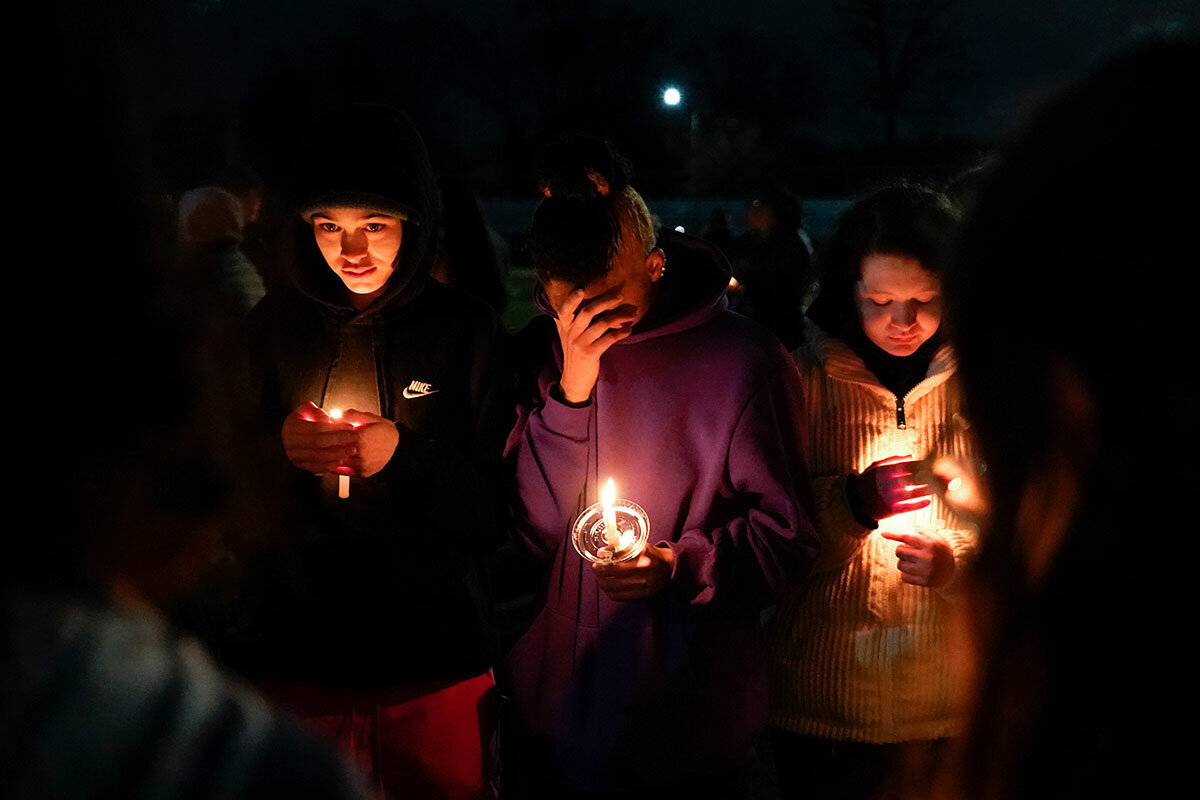
A look ahead
Thanks for joining us today. Tomorrow, we’ll have an early look at how the GOP field is shaping up ahead of the 2024 presidential election, following former Gov. Nikki Haley’s announcement that she’ll challenge her onetime boss, former President Donald Trump.


